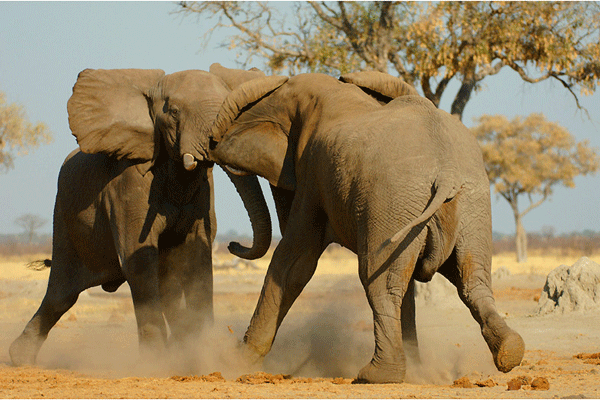
BY OSCAR NKALA
Zimbabwe must embrace adaptive natural resources management practices to ensure effective elephant conservation in its component of the Kavango Zambezi Transfrontier Conservation Area (Kaza-TFCA), a recent research report has revealed.
The Kaza-TFCA covers a surface area of 440 000 km in Angola, Botswana, Namibia, Zambia and Zimbabwe.
It is a wholly donor-sponsored initiative that seeks to promote co-existence between humans and a migratory trans-boundary elephant population of 230 000.
The report titled ‘A call to embrace adaptive management for effective elephant conservation in Zimbabwe’, it was written by Hlengisizwe Ncube of the Department of Forest Resources and Wildlife Management of the National University of Science and Technology in Bulawayo.
Ncube noted that like in most African countries, wildlife conservation in Zimbabwe was at a critical juncture, hamstrung by bureaucracy and threatened by human encroachment, which fuels poaching and habitat fragmentation.
Although the Zimbabwe Parks and Wildlife Management Authority (Zimparks) was once considered an African pioneer in effective wildlife and protected areas management, that reputation has been undone by a combination of internal and external factors.
“A perennially lean budget, the use of obsolete equipment, low morale among the staff and a high staff turnover because of a low skills retention capacity (now) constrain the activities of the department,” Ncube wrote.
- Chamisa under fire over US$120K donation
- Mavhunga puts DeMbare into Chibuku quarterfinals
- Pension funds bet on Cabora Bassa oilfields
- Councils defy govt fire tender directive
Keep Reading
“Although ZimParks (anti-poaching) patrol teams are augmented by state police in major protected areas, the rangers are sometimes injured or killed during contact with armed poachers with sophisticated weapons.
“The situation is made worse by fraudulent tendencies, where ZimParks officers, state police and politicians are incessantly implicated as accomplices in wildlife poaching syndicates.
“On the other hand, the techniques used by poachers are dynamic with recent elephant Loxodonta Africana poaching tactics involving lacing water sources and salt licks with cyanide poison, which also kills secondary targets such as scavenging vulture species.”
Further, the research found that Zimbabwe’s efforts to effectively manage and conserve its African elephants continued to suffer from a tragedy of policy inconsistency and duplication of efforts in wildlife conservation.
“First, there is a misguided tendency to draw contests between the old ‘tried and tested’ methods against the new innovative conservation initiatives,” Ncube added.
“The old conservation paradigm is constructed on a fortress model where a largely unfenced protected area is the epicentre of conservation activity.
“The new conservation model is pragmatic, with emphasis on the management of protected areas based on the ecological requirements of wildlife and the socio-economic aspirations of surrounding communities.”
Due to hunting bans, culling and a moratorium on the ivory trade, elephants have multiplied to become the de-facto flagship species of the Kaza TFCA biosphere.
The upsurge in human-elephant conflict has raised questions on how best to strike a balance between conservation and factors like biomass carrying capacity and human needs.
While short term remedies like creating dispersal opportunities and manipulating the distribution of key resources like water and forage could reduce elephant impacts on vegetation around artificial watering points, they are not the answer to conservation.
Elephant culling to protect vestigial pockets of floristically impoverished reserves was also ruled out for fear it could stimulate an increase in the population growth rate by eliminating of the effects of density-dependent factors.
The report also ruled out the use of porcine zona pellucida (pZP) contraceptives to control elephant birth rates, dismissing the solution as invasive and requiring boosts, which are both expensive and impractical for wild populations.
“The growing (Kaza-TFCA) elephant herd should, therefore, be recognised as an ecological entity – a resource to be conserved and harnessed, or something to cherish and to use,” Ncube stated.
“The magnitude of illegal elephant poaching calls for adaptive wildlife management and a re-thinking of wildlife conservation strategies which responds to previous experiences.
“Active involvement of local communities in mainstream conservation could harness indigenous knowledge systems for effective wildlife conservation.
“Local community involvement could be extended to quota setting of employment opportunities in mainstream conservation.
“Community scouts could be promoted and groomed into professional rangers.
“A healthy relationship among the ecological and the socio-economic systems is the primary basis for adaptive wildlife management.”
The Zimparks policy of leasing hunting concessions to private operators for management was found to be flawed and motivated by the lure of ‘windfalls’ in the form of concession fees. Leasing out concessions also presented secondary problems, such as how to monitor the activities of concessionaires without seemingly interfering.
Through leasing concessions, natural resources may be looted or mortgaged to predominantly foreign influences with unverified management concepts, the report noted.
“It is envisaged that a successful re-alignment of the human–wildlife coexistence conservation paradigm can be attained through the establishment of community share trusts, funded through levies on local ecotourism, sport hunting and extractive industries such as mining.”
The devolution of natural resources management could help finance compensation schemes in the event of human-wild conflicts.
The returns can be used to fund community-based capital development projects like value addition to non-timber forest products and human-wild conflict mitigatory initiatives like the ‘fencing people in, fencing elephants out’ concept.”










